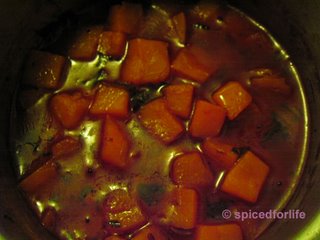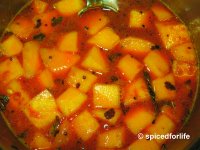Onion Vathakuzambu with potato kari (somewhere between sautéed and shallowfried) has to be at the top of my comfort foods list of all times. The sweetness of the red onion (big one!) complements the sour taste of the tamarind and the spice of the sambhar powder. Vathakuzhambu is also a perfect substitute for pickle. I remember when I was little, my grandmom used to thumb a little hole in the middle of one scoop of yoghurt rice and fill it with a dollop of vathakuzhambu. We cousins would try to imitate her way of eating, and giggle away.
Vathakuzhambu
Can be prepared with one of the following vegetables.
Garlic, Onion, Okra (Ladies finger), Cluster beans (Kothavaranga), Avaraikai, Sunberry (Manathakali), Drumstick, White Radish, pumpkin and even fried Appalam.
Other ingredients
Sambhar powder* - 2tsp. heaped (recipe below)
Tamarind paste - 1 tsp flat
Mustard seeds - 1 tsp.
Fenugreek seeds - ¼ tsp.
Tuar dal - ½ tsp.
Oil (sesame) - 2 tbsp.
Curry leaves and Asafoetida for garnishing.
Jaggery (optional)
Salt to taste
- Add the tamarind paste to 1 cup of warm water and set aside.
- Heat oil and add mustard seeds. Once they splutter, add fenugreek seeds and tuar dal.
- Add curry leaves and asafoetida (hing).

- Now add the vegetable (cut bite sized or cubed) and once sautéed add the sambhar powder and fry.
- Simmer and add the tamarind pulp, salt and let it boil.

- Let it boil until it cooks. If using appalam, add it when curry is ¾ done.
- Add 1/2 tsp of jaggery if using any vegetable other than red onion or pumpkin.
- When the oil separates on top, and the gravy reaches a syrup-like consistency the vathakuzhambu is ready!
Sambhar Powder recipe*

Coriander seeds - 250 gm
Dried Red Chilli - 200 gm
Peppercorn - 100 gm
Tuar dal - 100 gm
Chana dal - 100 gm
Fenugreek seeds- 50 gm
Turmeric - 2 tblsp
Dry roast all above separately and grind to a fine powder. For long term storage, refrigerate.


0 Responses:
Post a Comment